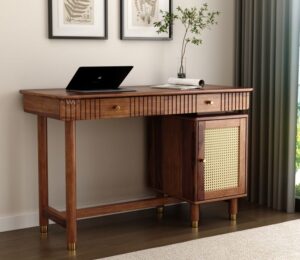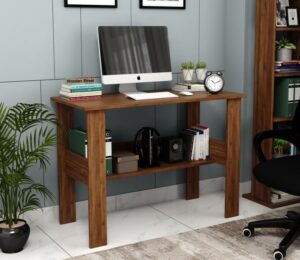In today’s fast-paced world, creating a dedicated workspace at home has become essential, especially for students and professionals juggling deadlines and online classes. A well-chosen study table can boost productivity, improve posture, and make studying feel less like a chore. But with so many options available—from sleek, minimalist designs to more traditional pieces—how do you pick the right size? It’s not just about aesthetics; the dimensions need to fit your space, your body, and your daily routine. At Wooden Street, we specialize in handcrafted furniture that blends functionality with timeless style, and we’re here to guide you through the process. Whether you’re hunting for a study table for students or a versatile wooden study table that doubles as a home office desk, getting the size right is key to long-term satisfaction.

Understanding Your Space: The First Step in Sizing Up
Before diving into measurements, take a good look at where your study table will live. Is it in a cozy corner of a bedroom, a shared living room, or a dedicated home office? The room’s layout plays a huge role in determining the ideal dimensions.
Start by measuring the available floor space. For a small apartment or dorm room, a compact study table around 36-48 inches wide and 20-24 inches deep might be perfect—enough for a laptop, notebook, and a cup of coffee without overwhelming the area. If you have more breathing room, like in a spacious study nook, you could opt for something larger, up to 60 inches wide and 30 inches deep, allowing for dual monitors or sprawling textbooks.
Consider traffic flow too. Leave at least 36 inches of clearance around the table for easy movement—think about pulling out a chair without bumping into walls or furniture. At Wooden Street, our wooden study tables are designed with modular options in mind, so you can pair a study table with storage underneath to maximize vertical space without encroaching on the floor.
Pro tip: Sketch a quick floor plan. Use tape to outline the table’s footprint on the floor and “test-drive” it. This simple hack can reveal if a certain size feels cramped or just right.
Ergonomics: Prioritizing Comfort for Long Study Sessions
Size isn’t just about fitting the room—it’s about fitting you. Poor ergonomics can lead to back pain, neck strain, and burnout, turning your study spot into a source of discomfort. The goal? A setup that supports your body during those marathon cram sessions.
Standard desk heights hover around 28-30 inches, but adjust based on your stature. For most adults, this keeps elbows at a 90-degree angle when typing, with feet flat on the floor. Shorter individuals might prefer 26-28 inches, while taller folks could go up to 32 inches. If you’re shopping for a study table for students—say, for a teenager who’s in a growth spurt—opt for adjustable models or pair it with a footrest.
Depth matters for arm reach: 24-30 inches allows you to pull your chair close without hunching. Width should accommodate your workflow—36 inches for basic note-taking, 48-60 inches if you’re spreading out research materials or using a desktop setup.
Don’t forget the chair! It should tuck under the table with 12-18 inches of knee clearance. Wooden Street’s collection includes ergonomic wooden study tables crafted from solid sheesham or mango wood, with rounded edges to prevent bumps and ample under-desk space for comfort.
Functionality and Features: Size Meets Practicality
A study table’s size should scale with how you use it. Are you a minimalist who needs just a surface for a tablet, or do you thrive in organized chaos with books, supplies, and gadgets everywhere?
For light use, like quick homework reviews, a narrow 24-inch deep table suffices. But for intensive work—think engineering students diagramming circuits or writers outlining chapters—go wider. A 48-inch study table provides zones: one for your computer, another for references, and a third for a lamp or planner.
Storage is a game-changer, especially in compact spaces. Look for a study table with storage options like built-in drawers or shelves. These add utility without bulking up the footprint—imagine sliding notebooks into side compartments on a 40-inch wide piece, keeping your surface clutter-free. Our wooden study tables at Wooden Street often feature dovetail joints for durable, hidden storage that enhances both form and function.
Think future-proofing too. A growing family might start with a kid-sized 36-inch table and upgrade later. Modular designs let you expand, like adding side tables for extra surface area.
Material and Style: How Size Influences Your Aesthetic
While size is functional, it ties into the overall vibe of your space. A massive oak study table might overwhelm a modern loft, just as a tiny glass-top desk could get lost in a rustic cabin.
Wooden options shine for their warmth and durability. A solid wooden study table in natural teak can anchor a bohemian setup, with sizes ranging from petite 30-inch consoles to grand 72-inch executive desks. Lighter woods like acacia suit brighter rooms, where a medium 42-inch width keeps things balanced.
Match the scale to your decor: In a minimalist Scandinavian space, slim profiles (under 20 inches deep) promote openness. For traditional homes, chunkier legs on a 50-inch table add grounded elegance.
At Wooden Street, sustainability meets style—our pieces are sourced from responsibly managed forests, ensuring your study table for students isn’t just sized right but also kind to the planet.
Common Mistakes to Avoid When Sizing Your Study Table
Even with good intentions, pitfalls abound. One biggie? Ignoring scale. A too-large table can make a room feel cave-like, while a skimpy one leaves you elbow-to-elbow with walls. Always measure twice—account for cords, lamps, and even a plant for that personal touch.
Another error: Overlooking versatility. A fixed-size study table might not adapt if your needs shift from student life to remote work. Flexible options, like foldable extensions, offer breathing room.
Finally, skimping on quality for size. A wobbly cheap desk, no matter how “perfectly” proportioned, won’t last. Invest in sturdy construction—Wooden Street’s kiln-dried woods resist warping, ensuring your table endures daily use.

Measuring Up: A Quick Sizing Guide
To make it concrete, here’s a handy table for common scenarios:
| User Type | Recommended Width | Recommended Depth | Key Features |
|---|---|---|---|
| Child/Teen Student | 36-42 inches | 20-24 inches | Adjustable height, small drawers |
| College Student | 42-48 inches | 24-28 inches | Study table with storage, cable management |
| Adult Professional | 48-60 inches | 28-30 inches | Spacious surface, ergonomic edges |
| Shared Space | 30-36 inches | 18-22 inches | Wall-mounted or foldable |
This chart is a starting point—tweak based on your measurements.
Bringing It Home: Final Thoughts on Your Perfect Fit
Choosing the right size study table boils down to harmony: between your space, body, and lifestyle. Start with honest assessments of your room and habits, prioritize ergonomics, and weave in features like storage for everyday wins. A thoughtfully sized wooden study table isn’t just furniture—it’s a productivity ally, turning study time into focused flow.
Ready to find yours? Explore Wooden Street’s curated selection of study tables for student and beyond. From petite wooden wonders to expansive workhorses, each piece is crafted to fit seamlessly into your life. Measure up, dream big, and create a space that inspires. Your ideal study table is waiting—sized just right.




